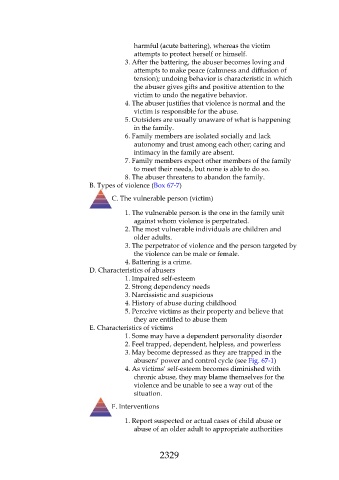Page 2329 - Saunders Comprehensive Review For NCLEX-RN
P. 2329
harmful (acute battering), whereas the victim
attempts to protect herself or himself.
3. After the battering, the abuser becomes loving and
attempts to make peace (calmness and diffusion of
tension); undoing behavior is characteristic in which
the abuser gives gifts and positive attention to the
victim to undo the negative behavior.
4. The abuser justifies that violence is normal and the
victim is responsible for the abuse.
5. Outsiders are usually unaware of what is happening
in the family.
6. Family members are isolated socially and lack
autonomy and trust among each other; caring and
intimacy in the family are absent.
7. Family members expect other members of the family
to meet their needs, but none is able to do so.
8. The abuser threatens to abandon the family.
B. Types of violence (Box 67-7)
C. The vulnerable person (victim)
1. The vulnerable person is the one in the family unit
against whom violence is perpetrated.
2. The most vulnerable individuals are children and
older adults.
3. The perpetrator of violence and the person targeted by
the violence can be male or female.
4. Battering is a crime.
D. Characteristics of abusers
1. Impaired self-esteem
2. Strong dependency needs
3. Narcissistic and suspicious
4. History of abuse during childhood
5. Perceive victims as their property and believe that
they are entitled to abuse them
E. Characteristics of victims
1. Some may have a dependent personality disorder
2. Feel trapped, dependent, helpless, and powerless
3. May become depressed as they are trapped in the
abusers’ power and control cycle (see Fig. 67-1)
4. As victims’ self-esteem becomes diminished with
chronic abuse, they may blame themselves for the
violence and be unable to see a way out of the
situation.
F. Interventions
1. Report suspected or actual cases of child abuse or
abuse of an older adult to appropriate authorities
2329

